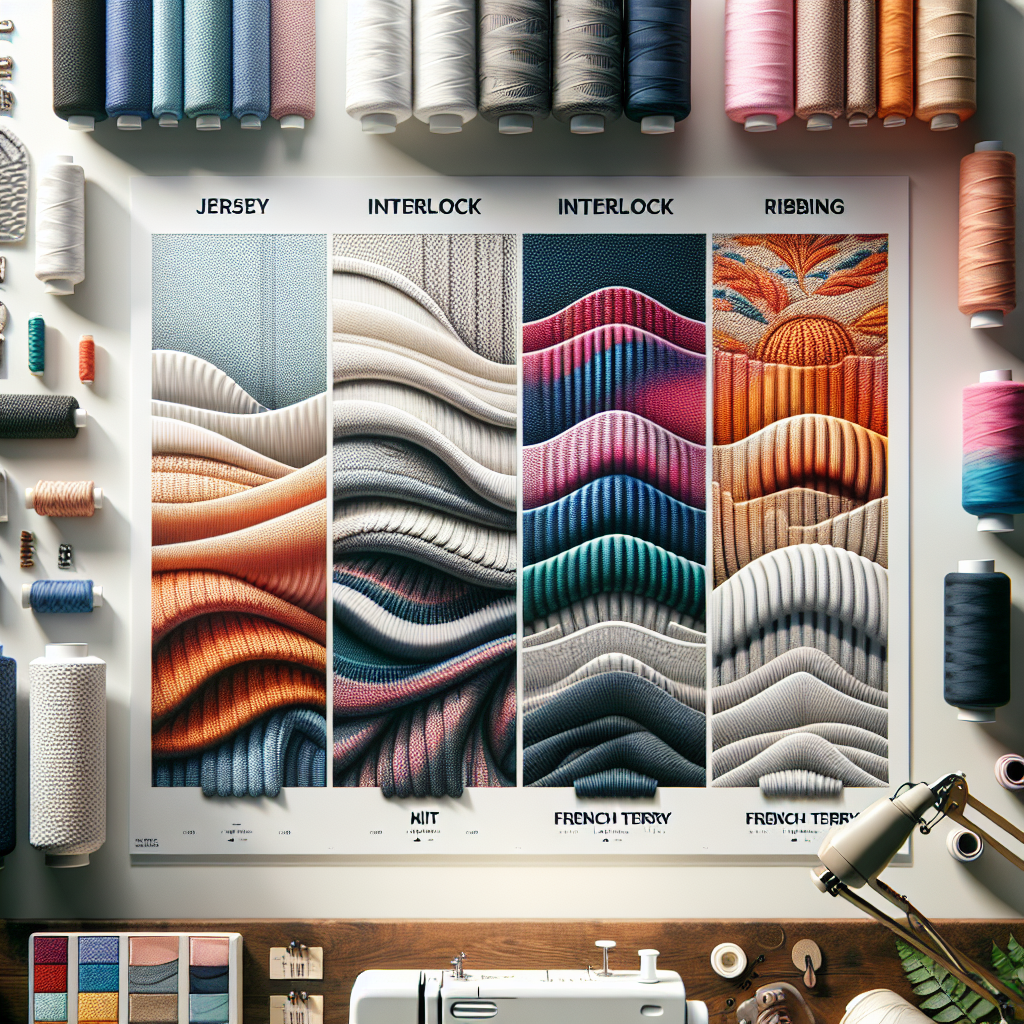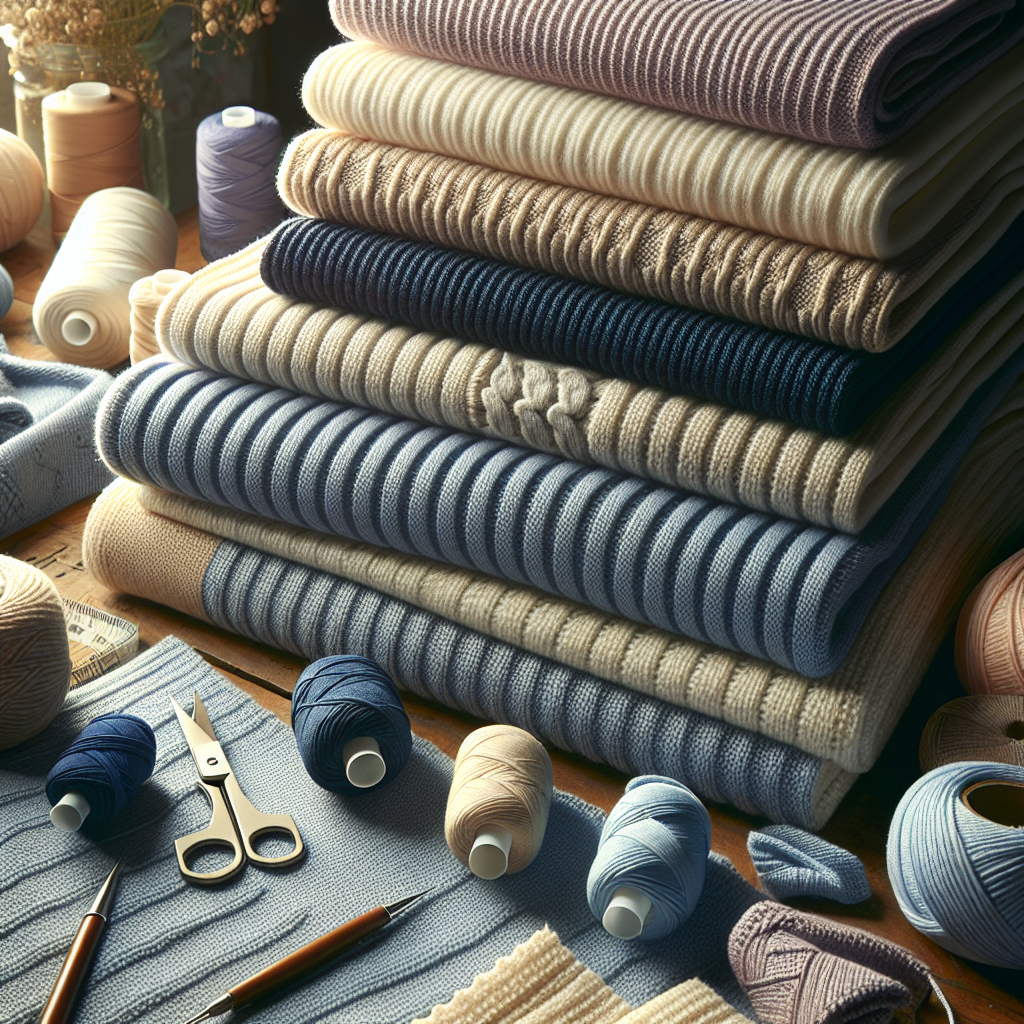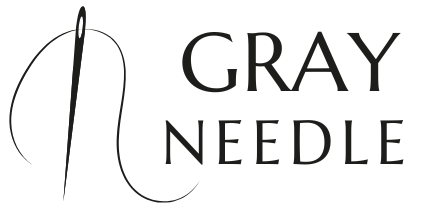Sewing with knits can be a delightful experience, but it requires an understanding of their unique characteristics. Unlike woven fabrics, knits are made from a series of interconnected loops, which gives them a natural stretch and flexibility. This stretchability is crucial when selecting patterns and techniques suitable for knit fabrics.
One of the first things to consider is the type of knit you are working with. Common types include:
- Jersey: A single knit fabric that is soft and has a smooth surface, ideal for t-shirts and dresses.
- Interlock: A thicker, more stable knit, often used for activewear and baby clothes due to its durability.
- Ribbing: Characterized by raised ribs, it is typically used for cuffs and neckbands.
- French Terry: A versatile knit with loops on one side, perfect for sweatshirts and loungewear.
Understanding these types will help you choose the right fabric for your projects and ensure a better fit. Additionally, knits behave differently when sewn; they can easily stretch out of shape if not handled properly. Therefore, using the right tools, such as a ballpoint needle and a walking foot, is essential for achieving a professional finish.
With the right knowledge, you can confidently embark on your sewing journey with knits. Visit our website to learn more and get started today! Click here.
Essential Tools and Supplies for Sewing Knits

When it comes to sewing knits, having the right tools and supplies is crucial for achieving professional results. Here’s a list of essential items every knit enthusiast should have on hand:
- Ballpoint Needles: These needles have rounded tips that slide between the fibers of the knit fabric without damaging them, making them ideal for sewing knits.
- Walking Foot: A walking foot helps to manage the layers of fabric evenly, preventing them from shifting during sewing, which is particularly important with stretchy materials.
- Clear Elastic: This is useful for stabilizing seams and hems while maintaining the stretch of the fabric, making it a favorite among knitters.
- Serger/Overlock Machine: While not necessary, a serger can provide professional finishes to knit edges, reducing fraying and adding stretch.
- Stretch or Knit Thread: These threads are designed to maintain elasticity, which is vital for seams that need to stretch without breaking.
- Fabric Clips: Instead of pins, fabric clips are great for holding knit fabrics together without leaving holes or causing distortion.
In addition to these tools, consider having a good quality cutting mat and rotary cutter for clean edges and precise cuts. Investing in the right tools will not only make your sewing easier but will also enhance the quality of your finished projects, allowing you to sew knits with confidence.
Choosing the Right Needle and Thread for Knits

Selecting the appropriate needle and thread is vital when working with knit fabrics, as it directly influences the quality and durability of your seams. Here’s what you need to know:
- Needle Type: Always choose a ballpoint needle for sewing knits. Its rounded tip is designed to slip between the fibers, preventing snags and runs in the fabric. Depending on the weight and type of your knit, you may select from various sizes, such as 70/10 for lightweight knits or 90/14 for heavier fabrics.
- Thread Selection: Use polyester thread or specialized stretch thread for your knit projects. Polyester thread is strong and has a slight stretch, making it ideal for seams that need to retain elasticity. Avoid using cotton thread, as it lacks flexibility and can lead to seam breakage.
- Thread Tension: Adjust your machine’s thread tension settings when working with knits. A looser tension can help accommodate the fabric’s stretch, while too tight tension may cause puckering.
- Bobbin Thread: It’s often advisable to use the same type of thread in the bobbin as you do on the top. This consistency helps maintain the stretch and strength of the seam.
By carefully choosing the right needle and thread for your knits, you’ll ensure that your sewing projects not only look great but also stand the test of time.
Techniques for Cutting and Handling Knit Fabrics

Handling knit fabrics can be tricky due to their stretchy nature, but employing the right techniques for cutting and managing these materials will greatly improve your sewing experience. Here are some essential tips:
- Use Sharp Scissors or a Rotary Cutter: A sharp pair of scissors or a rotary cutter is crucial for clean cuts. Dull blades can cause fraying and stretching, compromising the edges of your fabric.
- Cutting on a Flat Surface: Always cut your knit fabrics on a flat, stable surface to prevent slipping. Using a cutting mat can also help protect your workspace and ensure precision.
- Pinning and Weights: Instead of traditional pinning, which can distort the fabric, consider using pattern weights to hold your fabric in place while cutting. If you must pin, use fine, sharp pins to minimize any potential damage to the material.
- Consider Fabric Grain: Pay attention to the grain of the fabric when cutting. Always align your patterns with the stretch direction to ensure that your garments fit well and move with your body.
- Pre-Washing: Pre-washing your fabric before cutting is essential, as it helps to eliminate shrinkage and sets the fabric’s stretch. This practice not only saves you from future surprises but also helps in understanding how your fabric behaves.
By mastering these techniques for cutting and handling knit fabrics, you will set a solid foundation for successful sewing projects.
Tips for Stitching and Finishing Knit Projects

When it comes to stitching and finishing knit projects, using the right techniques can make all the difference in achieving a professional look. Below are some effective tips to elevate your knit sewing skills:
- Choose the Right Stitch: Select stitches that can accommodate the stretch of the fabric. For most knit materials, zigzag stitches or serger stitches are ideal as they allow the fabric to retain its elasticity without breaking the thread.
- Use a Stretch Needle: A stretch needle is designed specifically for knit fabrics. Its unique design helps to prevent skipped stitches and damage to the fabric fibers, ensuring a smooth sewing experience.
- Adjust Tension Settings: Experiment with the tension settings on your sewing machine. Knits often require a looser tension to accommodate their stretch, so make adjustments as needed for optimal results.
- Finish Seam Edges: To prevent fraying and maintain the integrity of your seams, consider using a serger or a narrow hem finish. You can also use a zigzag stitch along the raw edges if a serger isn’t available.
- Pressing Techniques: Use a low heat setting on your iron and a pressing cloth when working with knits. Excessive heat can damage the fabric, so gently press seams rather than ironing them.
Following these tips for stitching and finishing your knit projects will not only enhance the durability of your garments but also give them a polished appearance.
Common Mistakes to Avoid When Sewing Knits
Even seasoned sewing enthusiasts can encounter challenges when working with knit fabrics. Understanding common mistakes can help you avoid unnecessary frustration and ensure successful projects. Here are some pitfalls to watch out for:
- Using the Wrong Needle: One of the most frequent mistakes is using a standard sewing needle. Always opt for a stretch needle or a ballpoint needle designed for knit fabrics to prevent skipped stitches and snags.
- Neglecting to Test Stitch: Failing to test your stitch settings on a scrap piece of fabric can lead to unexpected results. Always perform a test run to check for stitch quality and tension adjustments.
- Overstretching Fabric: It’s easy to stretch knit fabrics while handling them. Be mindful of how you pull and guide the fabric through the machine, as overstretching can result in distorted seams.
- Ignoring Fabric Grain: Cutting your fabric on the wrong grain can affect how the garment drapes. Always pay attention to the fabric’s grainline to ensure your pieces are aligned correctly.
- Forgetting to Finish Seams: Skipping seam finishing can result in frayed edges and an unfinished look. Always use a serger, zigzag stitch, or other finishing techniques to secure your seams.
By avoiding these common mistakes, you’ll save time and effort on your knit projects, leading to more enjoyable sewing experiences. Visit our website to learn more and get started today! Click here.

